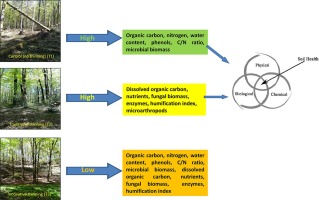当前位置:
X-MOL 学术
›
Forest Ecol. Manag.
›
论文详情
Our official English website, www.x-mol.net, welcomes your
feedback! (Note: you will need to create a separate account there.)
Responses of soil quality indicators to innovative and traditional thinning in a beech (Fagus sylvatica L.) forest
Forest Ecology and Management ( IF 3.7 ) Pub Date : 2020-06-01 , DOI: 10.1016/j.foreco.2020.118106 Federico Romeo , Giovanna Settineri , Maria Sidari , Carmelo Mallamaci , Adele Muscolo
Forest Ecology and Management ( IF 3.7 ) Pub Date : 2020-06-01 , DOI: 10.1016/j.foreco.2020.118106 Federico Romeo , Giovanna Settineri , Maria Sidari , Carmelo Mallamaci , Adele Muscolo

|
Abstract Soil has a pivotal role in keeping high the productivity of forest ecosystem but its physical and chemical properties are highly influenced by changes in forest species composition and forest management practices. Thinning is the most effective silvicultural practice used in Europe to increase the ecological and economic value of forest stands. The aim of this study was to identify the most appropriate forestry practice to preserve soil fertility and biodiversity in a beech (Fagus sylvatica L.) forest in Calabria, southern Italy. The effects of innovative (T3) and traditional (T2) thinning on soil properties with respect to unmanaged forest (T1) were assessed by using biological indicators. Results showed that T2 had the highest dissolved organic carbon (DOC) and the lowest water content (WC), organic carbon (OC) and nitrogen (N) amount. The humification index was the highest in T2 as well as fungi, ergosterol, fluorescein diacetate hydrolase (FDA) and catalase (CAT). The highest values of NO3−, SO4−, Na+, Mg2+ and Ca2+ were found in the T2. QBS-ar was significantly higher in T2 and T3 than in the T1. In short, our results evidenced that organic matter, total nitrogen, C/N ratio and water content cannot be considered alone or in combination indices of quality to evaluate the effect of thinning on soils. Rather, is the data crossing of microbiota and ions with organic matter pools (stable and labile) that can give important and accurate information on how thinning can affects soil biological properties that are strictly correlated to soil fertility and quality.
中文翻译:

山毛榉(Fagus sylvatica L.)森林中土壤质量指标对创新和传统间伐的响应
摘要 土壤在保持森林生态系统的高生产力方面发挥着关键作用,但其理化性质受森林物种组成和森林经营方式变化的影响很大。间伐是欧洲用来增加林分生态和经济价值的最有效的造林实践。本研究的目的是确定最合适的林业实践,以保护意大利南部卡拉布里亚山毛榉 (Fagus sylvatica L.) 森林中的土壤肥力和生物多样性。通过使用生物指标评估了创新 (T3) 和传统 (T2) 间伐对未管理森林 (T1) 土壤特性的影响。结果表明,T2具有最高的溶解有机碳(DOC)和最低的水含量(WC)、有机碳(OC)和氮(N)量。腐殖化指数在 T2 以及真菌、麦角甾醇、荧光素二乙酸水解酶 (FDA) 和过氧化氢酶 (CAT) 中最高。在 T2 中发现 NO3-、SO4-、Na+、Mg2+ 和 Ca2+ 的最高值。T2 和 T3 中的 QBS-ar 显着高于 T1。简而言之,我们的结果表明,不能单独考虑有机质、总氮、C/N 比和含水量,也不能将质量指标结合起来考虑来评估变薄对土壤的影响。相反,微生物群和离子与有机物质库(稳定和不稳定)的数据交叉可以提供重要和准确的信息,说明变薄如何影响与土壤肥力和质量密切相关的土壤生物特性。荧光素二乙酸水解酶 (FDA) 和过氧化氢酶 (CAT)。在 T2 中发现 NO3-、SO4-、Na+、Mg2+ 和 Ca2+ 的最高值。T2 和 T3 中的 QBS-ar 显着高于 T1。简而言之,我们的结果表明,不能单独考虑有机质、总氮、C/N 比和含水量,也不能将质量指标结合起来考虑来评估变薄对土壤的影响。相反,微生物群和离子与有机物质库(稳定和不稳定)的数据交叉可以提供重要和准确的信息,说明变薄如何影响与土壤肥力和质量密切相关的土壤生物特性。荧光素二乙酸水解酶 (FDA) 和过氧化氢酶 (CAT)。在 T2 中发现 NO3-、SO4-、Na+、Mg2+ 和 Ca2+ 的最高值。T2 和 T3 中的 QBS-ar 显着高于 T1。简而言之,我们的结果表明,不能单独考虑有机质、总氮、C/N 比和含水量,也不能将质量指标结合起来考虑来评估变薄对土壤的影响。相反,微生物群和离子与有机物质库(稳定和不稳定)的数据交叉可以提供重要和准确的信息,说明变薄如何影响与土壤肥力和质量密切相关的土壤生物特性。不能单独考虑总氮、C/N 比和含水量,也不能将其与质量指标结合起来考虑,以评估变薄对土壤的影响。相反,微生物群和离子与有机物质库(稳定和不稳定)的数据交叉可以提供重要和准确的信息,说明变薄如何影响与土壤肥力和质量密切相关的土壤生物特性。不能单独考虑总氮、C/N 比和含水量或将其与质量指标结合起来考虑来评估变薄对土壤的影响。相反,微生物群和离子与有机物质库(稳定和不稳定)的数据交叉可以提供重要和准确的信息,说明变薄如何影响与土壤肥力和质量密切相关的土壤生物特性。
更新日期:2020-06-01
中文翻译:

山毛榉(Fagus sylvatica L.)森林中土壤质量指标对创新和传统间伐的响应
摘要 土壤在保持森林生态系统的高生产力方面发挥着关键作用,但其理化性质受森林物种组成和森林经营方式变化的影响很大。间伐是欧洲用来增加林分生态和经济价值的最有效的造林实践。本研究的目的是确定最合适的林业实践,以保护意大利南部卡拉布里亚山毛榉 (Fagus sylvatica L.) 森林中的土壤肥力和生物多样性。通过使用生物指标评估了创新 (T3) 和传统 (T2) 间伐对未管理森林 (T1) 土壤特性的影响。结果表明,T2具有最高的溶解有机碳(DOC)和最低的水含量(WC)、有机碳(OC)和氮(N)量。腐殖化指数在 T2 以及真菌、麦角甾醇、荧光素二乙酸水解酶 (FDA) 和过氧化氢酶 (CAT) 中最高。在 T2 中发现 NO3-、SO4-、Na+、Mg2+ 和 Ca2+ 的最高值。T2 和 T3 中的 QBS-ar 显着高于 T1。简而言之,我们的结果表明,不能单独考虑有机质、总氮、C/N 比和含水量,也不能将质量指标结合起来考虑来评估变薄对土壤的影响。相反,微生物群和离子与有机物质库(稳定和不稳定)的数据交叉可以提供重要和准确的信息,说明变薄如何影响与土壤肥力和质量密切相关的土壤生物特性。荧光素二乙酸水解酶 (FDA) 和过氧化氢酶 (CAT)。在 T2 中发现 NO3-、SO4-、Na+、Mg2+ 和 Ca2+ 的最高值。T2 和 T3 中的 QBS-ar 显着高于 T1。简而言之,我们的结果表明,不能单独考虑有机质、总氮、C/N 比和含水量,也不能将质量指标结合起来考虑来评估变薄对土壤的影响。相反,微生物群和离子与有机物质库(稳定和不稳定)的数据交叉可以提供重要和准确的信息,说明变薄如何影响与土壤肥力和质量密切相关的土壤生物特性。荧光素二乙酸水解酶 (FDA) 和过氧化氢酶 (CAT)。在 T2 中发现 NO3-、SO4-、Na+、Mg2+ 和 Ca2+ 的最高值。T2 和 T3 中的 QBS-ar 显着高于 T1。简而言之,我们的结果表明,不能单独考虑有机质、总氮、C/N 比和含水量,也不能将质量指标结合起来考虑来评估变薄对土壤的影响。相反,微生物群和离子与有机物质库(稳定和不稳定)的数据交叉可以提供重要和准确的信息,说明变薄如何影响与土壤肥力和质量密切相关的土壤生物特性。不能单独考虑总氮、C/N 比和含水量,也不能将其与质量指标结合起来考虑,以评估变薄对土壤的影响。相反,微生物群和离子与有机物质库(稳定和不稳定)的数据交叉可以提供重要和准确的信息,说明变薄如何影响与土壤肥力和质量密切相关的土壤生物特性。不能单独考虑总氮、C/N 比和含水量或将其与质量指标结合起来考虑来评估变薄对土壤的影响。相反,微生物群和离子与有机物质库(稳定和不稳定)的数据交叉可以提供重要和准确的信息,说明变薄如何影响与土壤肥力和质量密切相关的土壤生物特性。











































 京公网安备 11010802027423号
京公网安备 11010802027423号